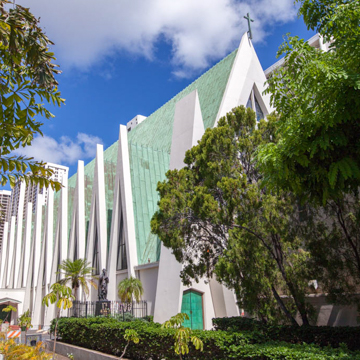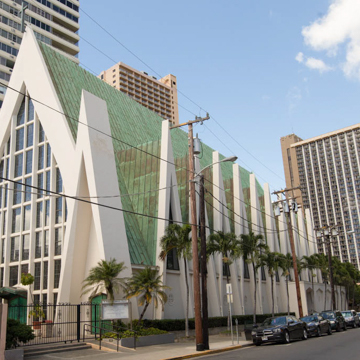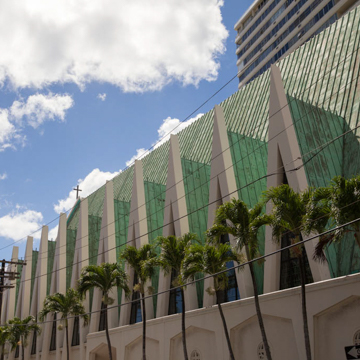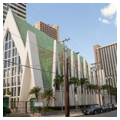Described by the media as “Polynesian gothic” and a “Gothic A Frame,” the soaring majesty of St. Augustine's has been enveloped by Waikiki's high-rises. Yet its presence cannot be denied, thanks to its steep-pitched, copper-covered gable roof and the ten equally vertical and pointed window bays bristling in harmony along both side walls.
The impressive interior is reminiscent of Dominikus Bohm's Frielingsdorf Church (1927) near Cologne, Germany, with its pointed concrete vaults springing from floor to ceiling. The vaults smoothly incorporate the side aisles through their shallow pointed arches. The arches rhythmically advance the eye to the chancel and its focal point, a six-and-a-half-foot statue of Christ on a koa cross that is set within a white, concrete niche above a white marble altar. The wood ceiling and triforium's triangular-shaped stained glass windows by Mader Company of Innsbruck, Austria, accentuate the concrete rib vaulting. Coconuts and red anthuriums figure prominently in some of the windows, and four of them depict episodes from the history of the Roman Catholic Church in Hawaii, including the replacement of the earlier lattice-walled St. Augustine church of 1900. The cast-plaster stations of the cross mounted on travertine plaques contribute to the church's beauty. The congregation originally wanted to acquire the property fronting on Kalakaua Avenue to provide an ocean view, but escalating land prices made that impossible.
George McLaughlin arrived in Hawaii in 1957 and designed a number of churches in the Islands, including Emmanuel Episcopal Church (780 Keolu Drive, Kailua) and Holy Trinity Roman Catholic Church (5919 Kalanianaole Highway, Kuliouou).




















